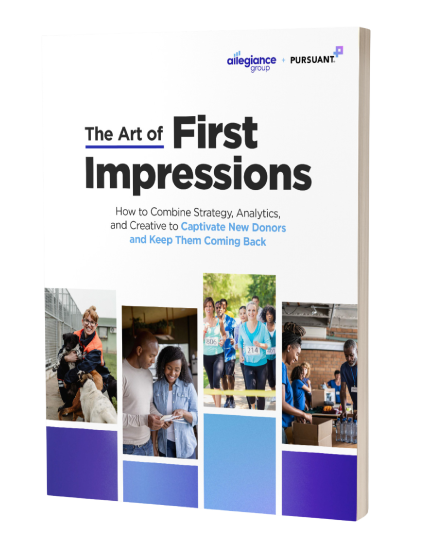7 Strategies for Starting an Effective Awareness Campaign

Awareness campaigns are typically based around a wider awareness day, week, or month. They are one of the most popular ways to educate people about your nonprofit and a specific cause.
If you want to make your nonprofit stand out from others promoting the same cause, try following these strategies for putting on an effective campaign:
- Do your research.
- Choose the right date.
- Find your target audience.
- Craft your campaign message.
- Secure sponsors and ambassadors.
- Use multiple channels.
- Optimize your donation site.
An awareness campaign cannot start without proper planning and resources. Are you ready to examine these ideas for your campaign launch? Let’s get started!
Partner will Allegiance Group + Pursuant to make a great first impression on supporters.
1. Do your research
The first part of starting an effective awareness campaign is doing your research. While awareness days are fairly common, you must find the right one that fits your mission. Otherwise, you won’t get as much attention as you might hope.
While doing your research, you should:
- Observe other charitable campaigns. Note what they’re doing well and what you could do even better.
- Determine the type of campaign you’ll run. Study your current donor information and decide what kind of campaign would excite them. This could mean determining whether they’re interested in annual giving or social giving.
- Think about long-term plans. Consider what part of your mission you want to focus on and the types of events your donors might support. You can also decide if you’re only trying to appeal to current donors or if you want to expand your network.
Doing your research before you get started is necessary so you can decide how you want to set up your awareness campaign. By being observant and making critical decisions, you’ll set your campaign up for success.
2. Choose the right date
If you want to run a successful awareness campaign, choosing the right date is an essential piece of the puzzle. Schedule your campaign so your team has enough time to plan and your donors have enough time to become engaged.
Here are a couple of items to consider when choosing your date:
- The set time frame. Usually, an awareness campaign has a set time frame you should keep in mind, which is during a larger awareness day, week, or month. Be sure your campaign coincides with the appropriate time frame.
- The length of the campaign. Once you’ve determined the time frame during which your campaign should occur, decide how long it will run. For example, an awareness week could coincide with the length of your campaign.
Having your date correspond with a larger awareness day, week, etc., can help build awareness about your cause and allow you to take advantage of the marketing surrounding the longer awareness period. Once you choose your date, start promoting it to your target audience so that they can start planning.
3. Find your target audience
Once you’ve determined the date(s) of your campaign, it’s important to determine your target audience, which will impact how you promote it. Using different communication methods for different groups of donors will help you achieve better overall outreach.
For example, if your donors are:
- Baby Boomers or the Silent Generation: You might consider performing your outreach through direct mail or email. These more traditional audiences tend to be more responsive to those methods of communication.
- Millennial or Gen Z donors: You may want to focus on communicating through social media and incorporate a peer-to-peer fundraising campaign. For more information, check out the OneCause guide to peer-to-peer fundraising.
4. Craft your campaign message
The main idea is that you want to harness your donors’ empathy. So, reach out to them in a way that resonates and is easily accessible. Your target audience plays a significant role in how you run your awareness campaign.
After you determine your target audience and how you’ll reach out to them, it’s time to craft your campaign message! Your goal is to increase awareness around your particular cause by putting in the extra effort to fine-tune your message.
All of this comes down to understanding the purpose of your campaign and demonstrating this purpose in your message. Just as you would communicate your purpose while sending out fundraising letters, your message should be loud and clear in your awareness campaign.
Keep these ideas in mind when crafting your message:
- Connect it back to your overall mission. Sometimes, nonprofits brand their awareness campaigns differently than their general message to make themselves stand out more. Be sure that your new message still connects back to your mission so that the donors interested in your cause will be likelier to complete their donations.
- Make it stand out. How can you ensure that your nonprofit’s message stands out from all the others with similar awareness campaigns? You can start by making it easy for donors to connect with your nonprofit and by reaching out on multiple platforms. From there, you’ll be able to start creating even more awareness (more on these ideas later!).
By keeping your awareness campaign’s message clear and tied to your overall charitable mission, you’ll be well on your way to having an effective campaign.

Pair your data insights & strategy with powerful creative to make a top-notch first impression.
5. Secure sponsors and ambassadors
When you think of sponsors and ambassadors, it might sound like a lot more work than you’d like to do. But both of these sources of support can greatly increase your donation revenue and help make your awareness campaign stand out.
Ambassador fundraising takes social fundraising up a notch, driving in more revenue by working with top supporters of a nonprofit. It can often be contests, challenges, or team fundraising. Here’s how it works:
- Your nonprofit chooses ambassadors from among your top supporters.
- These ambassadors are given social fundraising tools.
- The ambassadors then use individual fundraising pages to secure donations from their greater networks and attract more supporters to your cause.
If you want to learn more about this process, the OneCause guide to ambassador fundraising is a great place to start.
In addition to selecting ambassadors, be sure to secure sponsors. Partnering up with a sponsor can help you stand out from other nonprofits running awareness campaigns for the same cause. Try reaching out to local businesses, celebrities, or even a radio station so that you can drive in more revenue from their customers or listeners.
From there, consider running a t-shirt fundraiser as part of your campaign (with the help of a platform like this!) and list the sponsors on your t-shirts for extra exposure.
6. Use multiple channels
As we’ve already touched on, it’s essential to determine how you want to communicate with your supporters. When it comes to marketing and promoting your awareness campaign, it is helpful to use multiple channels for outreach.
Consider using:
- Social media
- Direct mail
- Phone calls
That said, you want to ensure you’re meeting your supporters on the platforms they’re using. For that reason, once you find your target audience, determine what they use most effectively. If you discover they’re more responsive to social media outreach, much of your focus should be on using social media platforms. This year’s large digital trend is social listening, so sending out surveys to your supporters is also a great way to learn what they use.
Using multiple channels to reach out can have a more significant impact on your fundraising results than if you only focused on one or two. Just be sure to use the platforms your supporters are most actively a part of and promote your awareness campaign through those channels.
6. Optimize your donation site
In preparation for your awareness campaign, there’s one more part that needs to fit in: there must be an easy way for supporters to donate! If you want to streamline this process, try using an online donation platform that offers the following features:
- Customization, so you can brand and embed the form into your website and determine the donor data you want to collect.
- Mobile optimization, so donors can easily give from their mobile devices.
- Analytics, so you can gather reports and data on the donations you’ve received.
To engage your website visitors, ensure your donation page is optimized and easy to use. Stand out with a simple process that minimizes donor shopping cart abandonment and encourages your supporters to give.
Starting an awareness campaign can seem daunting, but if you bring in the right resources and do your research, you can achieve a lot within the time frame. Try out these strategies to get you started on your best campaign yet!
Ready to dive in deeper? Download our guide on The Art of First Impressions.
About the Author
Kelly Velasquez-Hague brings over 20 years of fundraising, nonprofit management, and sales/marketing experience to her role as the Director of Content Marketing for OneCause. As a member of the OneCause sales and marketing team, Kelly manages the company’s content strategy and execution. She is passionate about empowering great missions and loves that her current role allows her to continue helping nonprofits reach new donors and raise more funds for their cause.